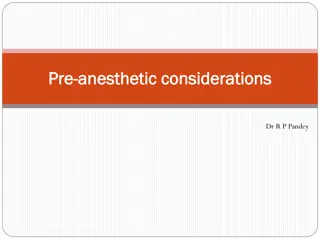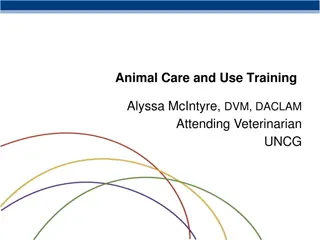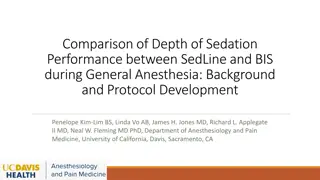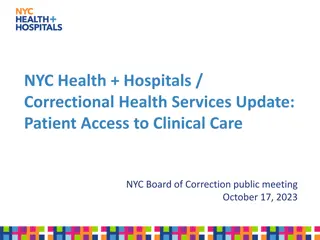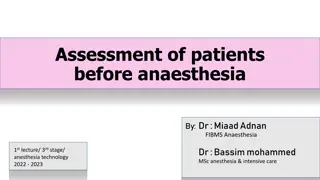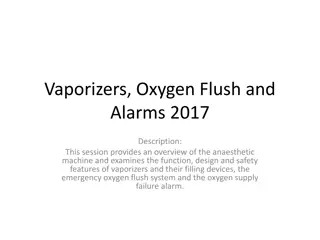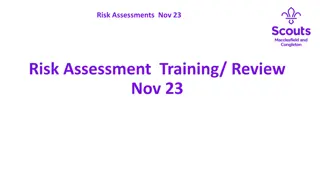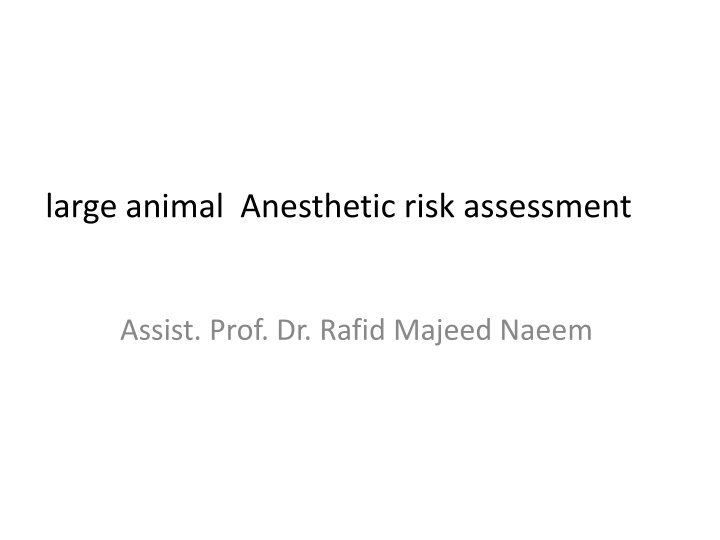
Large Animal Anesthetic Risk Assessment & Patient Health Evaluation
Anesthetic risk assessment is crucial in minimizing complications & ensuring safety during procedures. Evaluating preexisting cardiopulmonary, hematologic, renal, & neurologic conditions can help manage risks effectively. Understand the impact of these factors to enhance patient outcomes.
Download Presentation

Please find below an Image/Link to download the presentation.
The content on the website is provided AS IS for your information and personal use only. It may not be sold, licensed, or shared on other websites without obtaining consent from the author. If you encounter any issues during the download, it is possible that the publisher has removed the file from their server.
You are allowed to download the files provided on this website for personal or commercial use, subject to the condition that they are used lawfully. All files are the property of their respective owners.
The content on the website is provided AS IS for your information and personal use only. It may not be sold, licensed, or shared on other websites without obtaining consent from the author.
E N D
Presentation Transcript
large animal Anesthetic risk assessment Assist. Prof. Dr. Rafid Majeed Naeem
Anesthetic risk assessment perioperative assessment of anesthetic risk is a valuable exercise in order to minimize complications and optimize anesthetic safety. preoperative patient risk assessment Patient health assessment The preoperative assessment of an animal s health status is valuable 1. to acknowledge preanesthetic risks, 2. to identify management priorities 3. to advise clients appropriately prior to anesthesia and surgery
Patient health assessment 1. Pre existing cardiopulmonary pathology 2. Hematologic and biochemical abnormalities 3. Renal disease 4. Neurologic disease
1. Preexisting cardiopulmonary pathology Anesthetic agents cause cardiopulmonary depression and the presence of pre existing pathology is likely to predispose to greater anesthetic induced physiologic disturbance and may considered as anesthetic related mortality
2. Hematologic and biochemical abnormalities In particular, a. anemia will reduce oxygencarrying capacity and predispose to hypoxia, and b. hypoproteinemia has been theorized to increase the response of the patient to highly protein bound drugs and result in relative overdose. the laboratory biochemical or hematologic results are useful for a. identifying that surgery should be postponed b. Changing anesthetic protocol , c. undiagnosed pathology may be detected prior to anesthesia using routine screening may usefull for whether the owner decides to proceed with anesthesia/surgery
3. Renal disease is also important, if dehydration or uremia is present 4. Neurologic disease the occurrence of postoperative seizures, increased sensitivity to anesthetics
Large animal anesthesia morbidity (nonfatal complications) tend to occur more frequently than mortal events 1. Cardiovascular compromise were hypotension and cardiac arrhythmias notably bradycardia 2. Respiratory hypoventilation and hypercapnia and hypoxemia 3. In contrast to small animal anesthesia, horses appear to demonstrate a wider range of postoperative complications, including fractures and soft tissue injury like myopathy, and neuropathy and many result in death or euthanasia. . 4. postanesthetic colic
Large animal anesthetic mortality Risk of anesthetic death Many of these fatalities due to horses undergoing emergency gastrointestinal surgery that high risk patients
Causes of anesthetic death 1. In equine anesthesia, cardiac arrest and cardiovascular collapse were major causes of death, 2. Respiratory complications 3. Non cardiopulmonary causes: fractures on recovery, postoperative myopathy, and abdominal complications such as sepsis and colitis. 4. Rarely have horses been reported found dead or dying of unknown cause, perhaps because horses are more closely observed on recovery than many small animal patients.
Timing of anesthetic death Death may occurred 1. during induction, 2. during maintenance of anesthesia 3. the majority during recovery. the postoperative period as a major period of risk, although intraoperative concerns remain important, close attention to the postoperative period is also important in equine anesthesia.
commonly reported risk factors associated with death The work in equine anesthesia indicates risk factors include 1. emergency, 2. abdominal, and orthopedic surgery, 3. long operations, 4. poor health status, 5. extremes of age Informed consent the successful communication of these risks to owners and clients is central to the provision of safe anesthesia and the maintenance of realistic owner expectations. .


